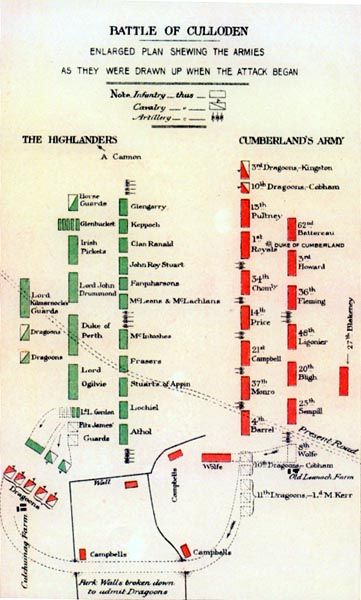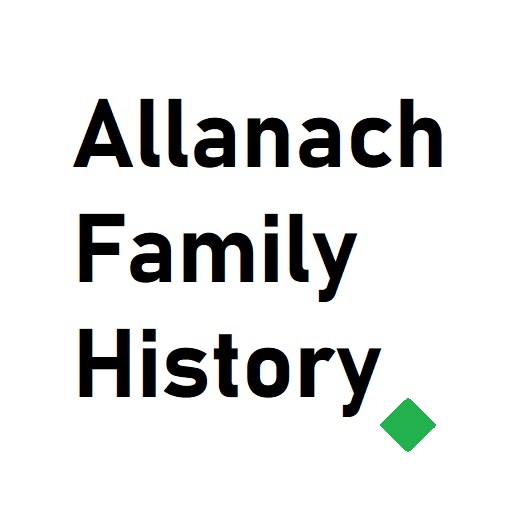Introduction
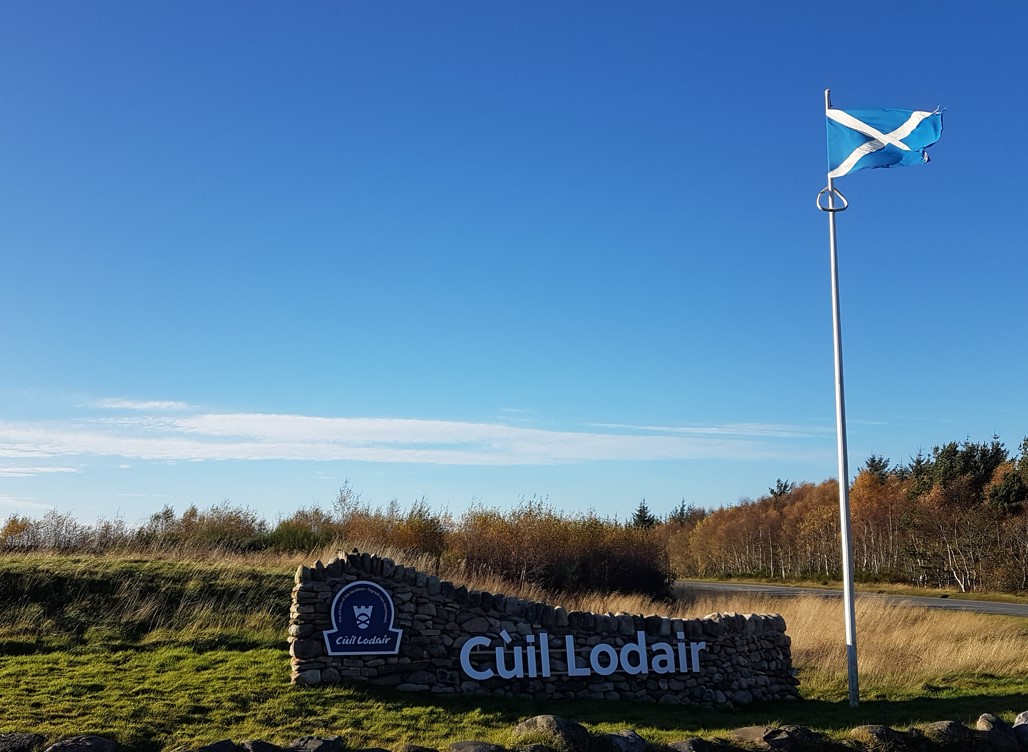
If you asked at the Culloden visitor centre if Allanachs fought there in 1746, the answer back would be ‘no’.
But I have slowly started to find more and more evidence that an Allanach did indeed fight there and was supported by the wider family.
Let us examine the evidence…
1. It would have been expected for local men to fight
The local laird John Gordon ‘Glenbucket’ strongly encouraged his local men to join the cause, sometimes not even accepting payment to avoid service in the Jacobite Army. Glenbucket raised around 200 men locally and the chances are high that at least one was an Allanach, especially given their proximity to Glenbucket’s seat of residence.
2. Scalan and oral histories maintain an Allanach fought at Culloden
Scalan was a Catholic Seminary located in Glenlivet a few miles over the Ladder Hills from Glen Nochty. You can view the local area and the history of the Seminary in this short film below.
Their magazine has a couple of mentions of the oral histories as to who fought at Culloden from
the local population, including John Allanach (merchant).
From Scalan017, published 1998
Robbie Lamb and the Jacobites of Glenlivet
James Cameron Stuart
I was interested in Stuart Mitchell’s article in the June issue of Scalan News relating to the men from Glenlivet who fought in the 1745 uprising. I recall sitting with Robbie Lamb in his house, Fuerandearg at Larryvarry, when he gave me a list of men he believed went from the Braes of Glenlivet area to Drummossie Muir to fight for Bonny Prince Charlie. As older local people will recall, Robbie was a great patriot and a highly intelligent man who wrote regularly for the press drawing attention to the depopulation of upland areas like his own. A reading of the list, which is typed and dated 22.8.62, confirms several names mentioned in the June issue. I am glad to see that at least five Stuarts took to the field on that sad day for our Church and, ultimately, for the Highland way of life with its language and culture. The list is headed THE MEN WHO WENT FROM GLENLIVAT TO DRUMOSSIE MUlR (CULLODEN) TO FIGHT FOR PRINCE CHARLES EDWARD STUART – 1746. The names and places follow:
Rev. Father John Tyrie, Bochel
John Allanoch, Merchant,
Clachmore James Bowie, Sovie [Suie], Glenlivat
Donald Fleming, Mill of Achdrignie (wounded)
Robert Fleming, Mill of Achdrignie
John Gauld, Achnasgra, Braes of Glenlivat
Thomas Gibenich, Scalan, Braes of Glenlivat
Alexander Gordon, Backside of Clachmore
Robert Gordon, Nether Clachmore
Alexander Grant, Calier
Alexander Grant, Backside of Clachmore
John Roy Grant, Demichmore
ColI MacDonald, Badivochal
James MacDonald, Badivochal
John MacKay, Merchant, Balno
Robert MacKay Nether Clachmore
George MacLaughlan, Calier
John MacLaughlan, Badivochal (labouring man – 69 years)
William MacLea, Sovie
Colin Moir, Badivochal
John Ross (Servant), Scalan Seminary
George Stuart, Badivochal
Peter Stuart, Badivochal
William Stuart, Clachmore
Williain Stuart, West Achavaich
. John Rattray, Balno
Robert Ross, Tomnalinan, Glenlivat
John Gordon (Ensign), Backside, Clachmore
by Robbie Lamb. Uandhu.
From Scalan018, published 1999
Readers Write
I am grateful to Jimmie Cameron Stuart for giving us Robbie Lamb’s list of 28 men from the Braes of Glenlivet who fought with the Jacobite army at Culloden (ScN 17). It is particularly fascinating that the names must have come from local family traditions that had survived well into this century, since the various Lists of Rebels identify only the Rev. John Tyrie and Donald Fleming as specifically present at Culloden. Jimmie ended his article by expressing pride in the five men of his name who fought for the Stuarts. However, he will be glad to know that there were actually eight Stuarts in Robbie Lamb’s list, four of them concealed by their patronymics: John Allanach – Clashnoir; Colin Moir – Badevochel; Thomas Cibenach – Scalan; William McLea Suie. And Robbie Lamb’s Peter Stuart from Badevochel was in fact alias Dow.
Yet another seven Stuarts were among 13 additional Braes men identified in the Lists of Rebels as having ,
carried arms’: Allan McLea – Badeglashan; John More Sr and Jr – Eskemore; Peter More – Knockandhu; John Stuart – Achnascra; Donald Stuart alias Dow – Clack; Robert Stuart Badevochel. Also William McLea, a servant from Morinsh, was noted as later being ‘in the Braes of Glenlivet’.
Stuart Mitchell, Turriff.
3. Historical Theses
This oral history from Scalan is supported by Historical Notes : Or, Essays on the 15 and 45 / by D. Murray Rose, published in 1897(ch. XIII)
MORAYSHIRE JACOBITES.
In Morayshire the Jacobites received a considerable accession of strength, and the list of ” Prince
Charlie’s Friends ” in the district is more full than that for any other quarter. This may have been due
in a measure to the vigilance and exertions of Mr John Campbell, supervisor of excise, Elgin, and his
assistants, as well as to the fact that the list includes many Inverness- shire names — not elsewhere
to be foimd. It therefore possesses a more than local interest.
The remarks concerning some of the followers of the Prince are curious. There was Charles Fraser of
Fairfield, who sold his commission in Cornwallis’ regiment to become adjutant-general in the army
of Charles; while another Fraser, the tacksman of Latehome, was an officer, and violently zealous. Of
the activity of Glenbucket there can be no question, for, although sufi’ering intensely from
rheumatism, he buckled on his claymore, and woe betide the man who refused his call !
It will be noticed how many were forced out, and how Cluny Macpherson is said to have compelled
his retainers to carry arms under threats of burning their belongings ; —
William Anderson, wigmaker, Inverness. Subordeniug in- dependent companies to join rebel army.
John Allanock, merchant, Clashmoer. Carried arms in rebel army as a private man.
Thomas Bain, shoemaker, Inverness. Envigiling independent companies to join rebel army.
John Bremner, servant, Jackburry. Carried arms as a volunteer in rebel army.
John Brown, Ballindoun. Was a private in rebel army, forced out and deserted.
John Bain, jun., Glenconles. Forced to serve as a private in said army and submitted to King’s mercy.
Archibald Bain Stewart, Delavoir. Forced to serve as a private in said army and submitted to King’s
mercy.
Angus Briber M’Kinteer, Auchloune. Served as a private in rebel army and was active in plundering.
John Binnachee, weaver, Belandie. Carried arms, being forced out, has submitted himself.
James Bowie, Sami. Deserted from rebel army which he had joined.
Eobert Cuthbert, shoemaker, Inverness. Endeavoured to trapan independent companies into
rebellion.
John Clark, indweller, Euthven. Was a quarter-master in rebel army and very active in his station.
John Gumming, residenter, Inverness. Voluntarly entered rebel service and got an officer’s
commission.
John Cuming, Tombea. Was an oflticer in rebel army, but deserted and has submitted.
Lauchlan Cuming, Tomintoul. Carried arms as a private man.
Robert Cameron, Keppoch. Was a private in rebel army, but forced out, has submitted.
John Cruickshank, deserter, Delavoiar. Carried arms as a private man.
‘Private man’ would suggest John Allanach volunteered and was not forced into Glenbucket’s army.
4. Attestations after Culloden
I recently found this amazing document from 1855. It was hidden behind a master’s certificate qualifying George Allanach to work as a sea Captain . There were identical Master Certificate – one in the name of George Stuart and one in the name of George Allanach.
In the below attestation, George is stating that his family used the name Stuart but had changed to Allanach as ‘from some cause connected with the last Rebellion in Scotland his Father changed his surname of ‘Stuart’ to that of ‘Allanach’.
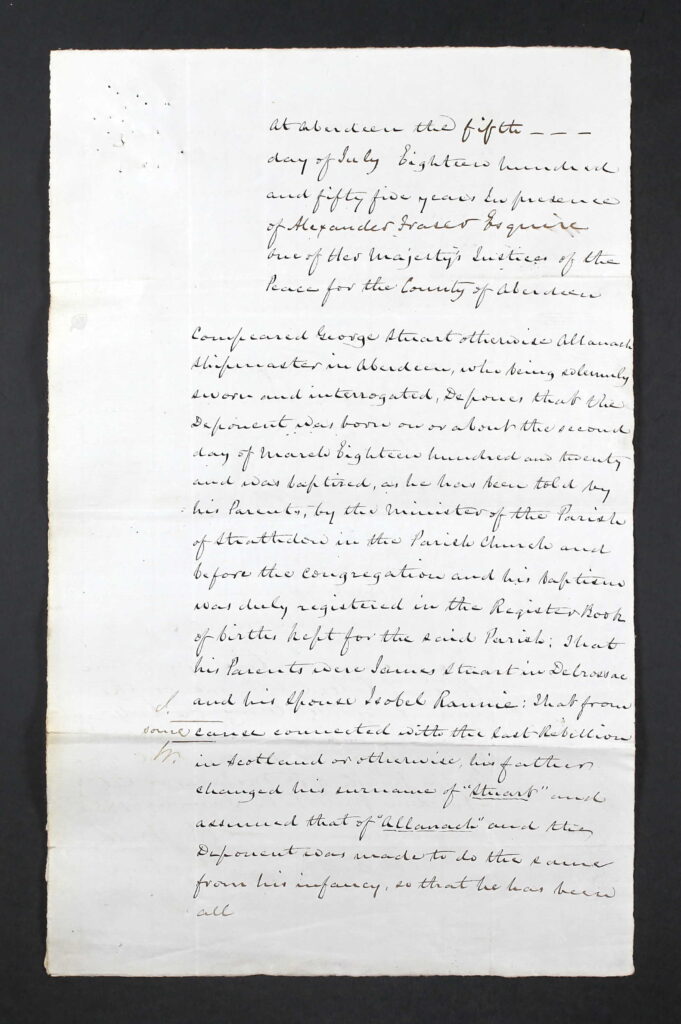
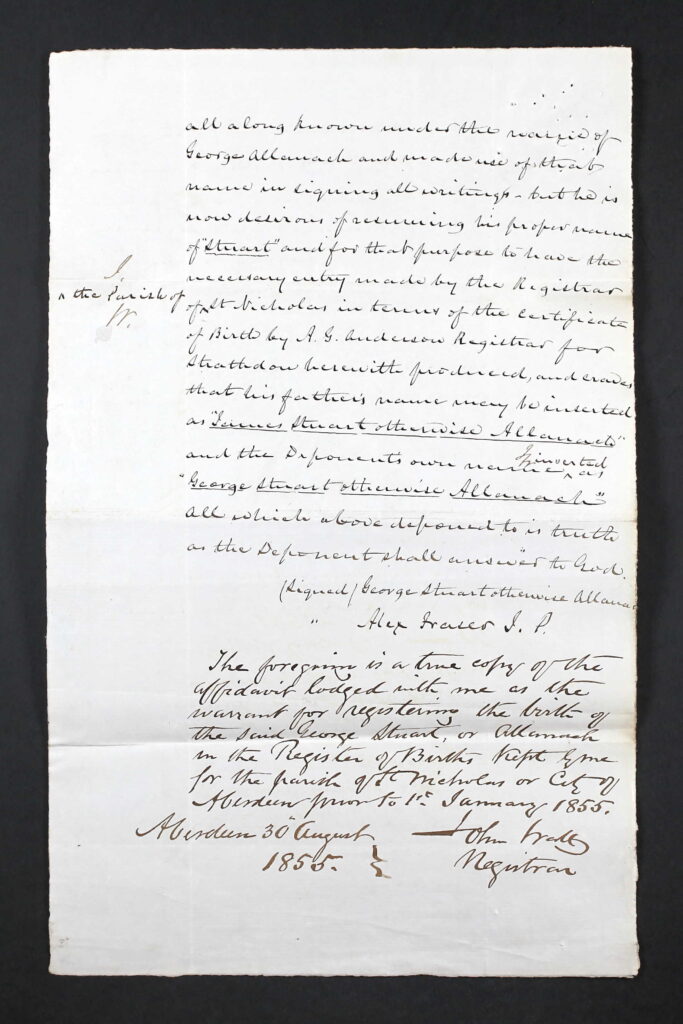
5. Physical Evidence
A coin from 1743 had been passed down to me. It was very well worn as though it had been rubbed for generations for luck.
I heard a rumour that it had been found on the Battlefield of Culloden on the morning of the battle and kept for good luck.
When I examined the coin more closely I could see two letters very very faintly inscribed ‘C’ and ‘R’. My theory is that this coin was used by Jacobites to identify one another (CR standing for Charles Rex or Bonnie Prince Charlie) and that a carrying a simple coin would not have aroused suspicion.
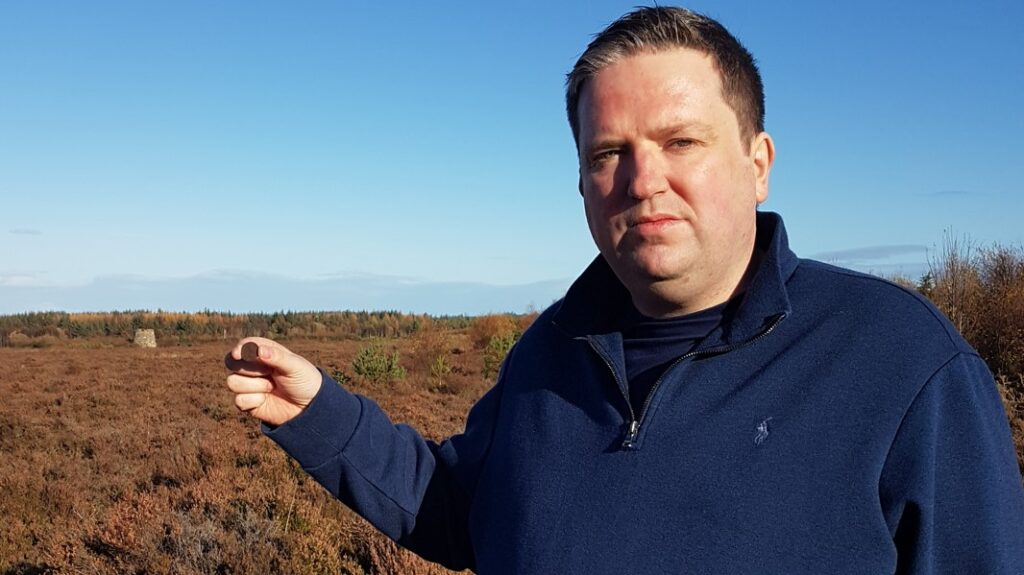
Me with the coin at Culloden on the Jacobite line
What would Culloden have been like for an Allanach fighting there?
Luckily Glenbuckets men were sent left so did not join the fatal charge from the right flank. It is also told that Glenbuckets men escorted Bonnie Prince Charlie off the field.
